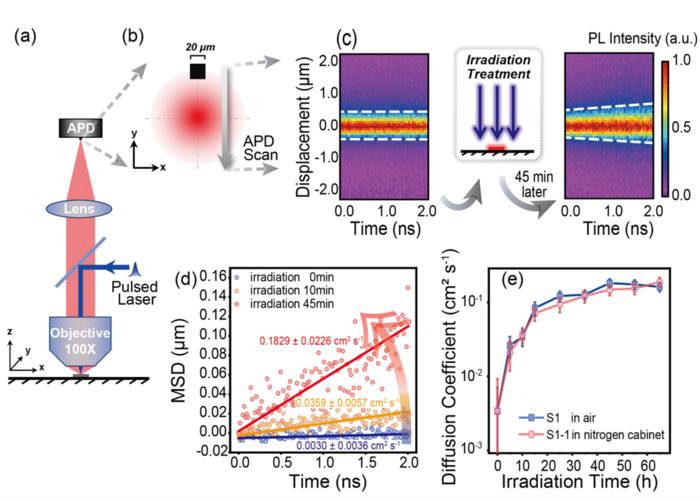Recent advancements in the field of optoelectronics have brought to light a groundbreaking discovery regarding exciton transport in organic semiconductors. A collaborative team of researchers from Tsinghua University and Jilin University has published a compelling study in Opto-Electronic Advances that sheds light on how light irradiation can significantly enhance the diffusion of excitons within organic molecular crystals. This innovation poses a potential game-changer for the performance of organic semiconductor devices that are integral to technologies such as organic light-emitting diodes (OLEDs), flexible solar panels, and advanced sensors.
The significance of excitons in organic semiconductors cannot be understated. These bound states of electrons and holes are crucial for the mechanisms underpinning light absorption and subsequent energy conversion. Despite the inherent advantages of organic materials, such as low cost and mechanical flexibility, the relatively inefficient transport of excitons presents a bottleneck in optimizing device performance. In comparison to their inorganic counterparts, organic semiconductors typically demonstrate sluggish exciton mobility, necessitating innovative solutions to overcome these limitations and enhance the operational functionality of optoelectronic devices.
Historically, significant research efforts have been directed toward the chemical synthesis of novel organic materials, aimed at scaffolding superior transport properties. While successful in some cases, these strategies often yielded isolated nanostructures or materials optimized on ultrafast timescales that do not translate well to practical, long-term applications. Taken together, this situation has highlighted the pressing need for alternative methodologies to bolster exciton transport, leading to the exploration of light-activated strategies as a viable solution.
The recent study led by Professors Hongbo Sun and Honghua Fang from Tsinghua University, alongside Professor Bin Xu from Jilin University, has trailblazed a new path in this arena. Their research employed transient photoluminescence microscopy to meticulously observe exciton transport in a specifically selected organic molecular crystal: 2,2’-(2,5-bis(2,2-diphenylvinyl)-1,4-phenylene) dinaphthalene, commonly referred to as BDVPN. What emerged from their investigation was nothing short of astounding. The team discovered that through iterative exposure to light, the diffusion coefficient of excitons improved dramatically, increasing by three orders of magnitude—an unprecedented leap from approximately 10^-3 cm^2 s^-1 to readings exceeding 1 cm^2 s^-1.
Furthermore, the enhancement of diffusion length—the distance over which excitons can travel without losing energy—increased significantly from below 50 nanometers to nearly 1 micrometer. This remarkable transformation underscores the efficiency of light irradiation in altering the structural dynamics within BDVPN, thereby facilitating an enriched transport environment for excitons. The researchers meticulously eliminated the influence of environmental factors, establishing that the observed improvements were indeed rooted in intrinsic structural alterations brought about by light exposure.
Delving deeper into the molecular architecture of BDVPN revealed several key features that play pivotal roles in its enhanced transport properties. The molecule’s twisted and rotationally flexible framework, along with unique intermolecular interactions—including C–H···π and H···H interactions—enable the necessary structural reorganization upon exposure to light. This allows for the retention of molecular stacking order amidst modifications, thereby paving the way for efficient exciton diffusion over extended timeframes.
Interestingly, the study reported that both coherent laser light and cost-effective incoherent LED sources were capable of inducing these transport enhancements. This finding not only points to the versatility of the irradiation process but also underscores its practical application across different light sources. Importantly, the improvements in exciton transport properties exhibited remarkable persistence, lasting for months following irradiation treatment, thus offering a promising avenue for advancing the performance and longevity of organic electronic devices.
The implications of these findings extend far beyond the immediate enhancements observed within BDVPN. This research sets the stage for further investigations into the mechanistic linkages between structure and transport enhancement in organic semiconductors. The collaborative team intends to unravel the structural modifications induced by light irradiation, hoping to broaden the applicability of this technique across various organic material systems. Such advancements could significantly contribute to addressing the current limitations in exciton transport mechanisms, fostering innovations in device efficiency and sustainability.
As the field of organic optoelectronics continues to evolve, the strategies laid out by this research invite further exploration into the manipulation of molecular structures via environmental stimuli, particularly light. The prospect of optimally tuning the transport characteristics of organic semiconductors through non-invasive means heralds a new age of adaptable and high-performance optoelectronic devices that could revolutionize consumer electronics and energy solutions.
In conclusion, the work unveiled by this research team represents a significant milestone in the quest for efficient organic semiconductors. By revealing that light irradiation can induce profound changes in molecular structures, leading to enhanced exciton transport, they have opened new horizons for both researchers and industry professionals. The integration of these findings could not only enhance how we create next-generation devices but also push the boundaries of current technology, leading to innovative solutions across various sectors, from renewable energy to advanced electronics.
Subject of Research: Light-Induced Enhancement of Exciton Transport in Organic Molecular Crystals
Article Title: Light-Induced Enhancement of Exciton Transport in Organic Molecular Crystals
News Publication Date: TBD
Web References: TBD
References: TBD
Image Credits: OEA
Keywords
organic semiconductor, exciton transport, light irradiation, optoelectronic devices, BDVPN




